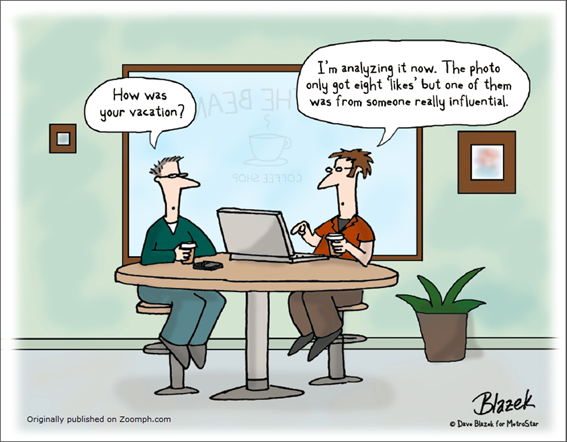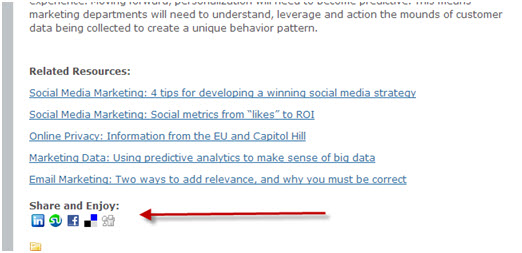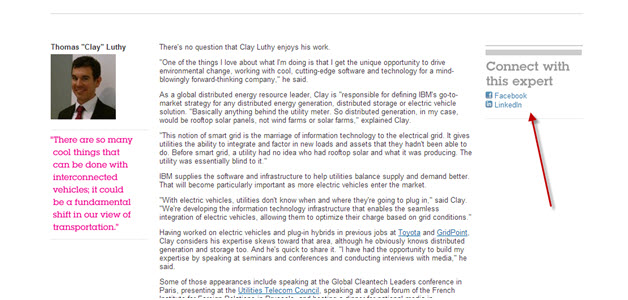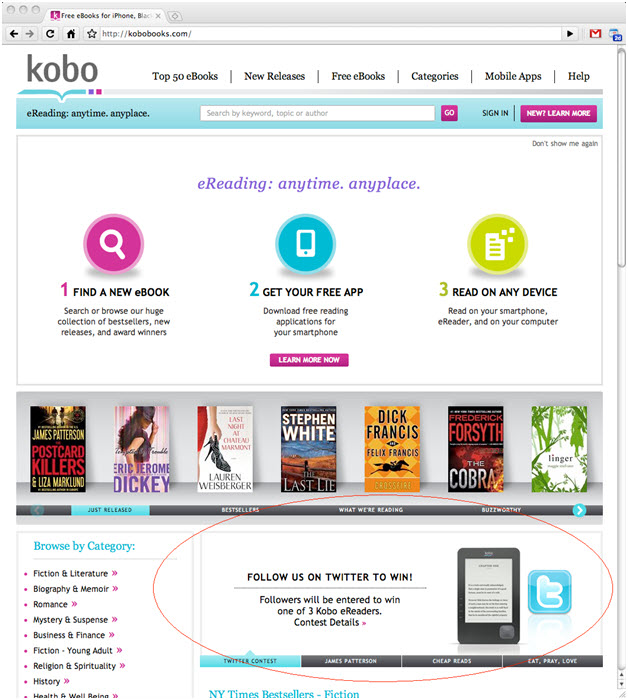Social Media Marketing: 4 questions to ask yourself about social media buttons
A common question we often hear about social media is “I put some social media elements onto my page and have not seen much of a difference …”
I’m sure you can relate, because social media icons are everywhere. On landing pages. In emails. Heck, I even saw some on a billboard while I was driving the other day.
Now, on behalf of Facebook, Twitter, LinkedIn and their investors, I’d first like to thank you marketers of the world for all of that free co-op advertising.
All kidding aside, let me throw the questions back at you to help you get the most value from your sharing icons. In today’s MarketingSherpa blog post, we’ll focus on three questions you should ask yourself about your company’s use of social media icons.
Question #1. Should we be using social media icons?
All jokes about free advertising aside, most marketers likely will find some value in using social media icons. And, here’s the key. While the value might not be great, it is likely higher than the cost.
Because, frankly, as marketing tactics go, simply slapping a few social media icons or sharing buttons on a landing page is fairly easy to do. Almost any value you get creates an ROI since it is higher than the minimal cost involved.
For example, AT&T added Facebook and Twitter icons into an email newsletter.
This was one small part of a program that helped the AT&T Developer Program increase its Twitter audience 136% and Facebook audience 113%.
Of course, as you’ll see in the case study above, the team at AT&T did much more than just add a few icons to an email to get that lift. But since the cost, in both IT execution to add the buttons and real estate on the email, was likely so low, and it certainly couldn’t have hurt their efforts, why not add social media icons?
Well, here’s why not. For most brands, the answer is simple: not every brand needs or should be using social media icons and sharing buttons. For example, I interviewed Steve Parker, Vice President, Direct Marketing, firstSTREET, in the MarketingSherpa webinar “Optimization: A discussion about an e-commerce company’s 500% sales increase.”
“In our case given our target market, you’re looking at an age 75+ customer, they’re not big social users. And, the ones who are on social media, they really just want to see pictures of their grandkids and their kids. So they’re not going to be as interactive in the social world. So from our standpoint, it’s pretty low on the priority list. There are no social buttons on this website,” Steve said.
He went on to share, “We’ve tested a little bit of that on some of our other properties. As baby boomers, the younger part that grew up with some social media lives grow older, yes, that will get more important. For my particular target market at this point in time, it doesn’t help.”
Question #2. Which social media icons should we use?
Ask your audience in direct conversations, in surveys, through customer service interactions and other customer-facing employees: what social networks do they use?
Then, be present on those platforms. See how they’re using social media.
And, look at your analytics.
Here on the MarketingSherpa blog, you’ll notice the prime social sharing button we use is from Twitter.
That’s because when we looked at our analytics, more inbound traffic came from Twitter than from any other social network.
You might also notice, at the bottom of our blog posts, we have social media sharing icons as well.
That’s because the rest of our inbound social network traffic came from LinkedIn, StumbleUpon, Facebook, Delicious and Digg.
Your analytics won’t be foolproof. Over time, this becomes a self-fulfilling prophesy (we receive more Twitter traffic because we encourage the audience to share on Twitter), but combining your analytics with active listening to your audience through many means will at least get you in the ballpark of how they want to interact with your brand using social media.
Question #3. Why should your customers follow you?
Start with developing a strategy that is focused on a clear value exchange.
Often, marketers will stick an icon on a homepage or a landing page and hope someone clicks on it. But the problem with that is there are no clear expectations set up beforehand that offer users any real value in exchange in return for joining your social networks.
Marketers that take the time for value proposition development to answer the fundamental question at the heart of all social media marketing – “If I am your ideal customer, why should I follow your Twitter account instead of your competitors?” – will likely see more success in their social media marketing efforts because they clearly explained the incentives and benefits available to their customers in exchange for their likes, follows, pins, shares and +1’s and etc.
– Adam Lapp, Associate Director of Optimization and Strategy, MECLABS
This is a little easier for natural content creators, like newspapers and magazines. Customers are used to turning to you for content they value, and they likely see the value in a simple social media icon as one more way to get that content from you.
For other brands, a social media icon may not be enough. You may need to add value-based messaging, such as “Follow us for the latest updates on waterproof sprockets,” or even “Follow us for exclusive discounts on polarized sunglasses.”
You may also move beyond just your brand icons, and involve your people, sinceafter all, people are inherently more social than faceless companies. For example, IBM invites you to connect with their experts …
When all else fails, and you have difficulty identifying and communicating value, you can always turn to incentive, the bacon of marketing tactics, as Kobo does here with a Twitter contest …
The Twitter contest boosted followers 43% for Kobo.
Question #4. What else should I think of beyond the icon?
Every brand wants followers, but how many brands really want to be a leader?
So, you’ve got these followers, where are you going to lead them now. Sure, you could try to use that social platform to sell, sell, sell.
Or, you could actually be social, and use it to deepen engagement, as Jonathan Greene suggested …
Currently, the best thing you can do with social media in terms of increasing conversion efforts is to focus on engagement; which will give potential converts a better understanding of your company and products so when it comes time to make a decision – you’ve helped them make an informed one.
I would also add that while social media is great for nurturing leads, it’s also important to remember that users will unlikely purchase directly from a social platform unless their motivation is really high.
So efforts to affect sales directly from social platforms are generally doomed to failure because of the nature of social media. Conversion focused on a direct sale on your social media platforms is almost antithetical to engagement when you think about it.
In one case, you’re asking people to leave your platform and accomplish a task and in another, you’re asking them to stay and hang out with you, so the focus should be one or the other and I recommend engagement.
– Jonathan Greene, Business Intelligence and Social Media Analyst, MECLABS
Cartoon attribution: Dave Blazek and Mark O’Collin
Related Resources:
Social Media Marketing: Is in-stream e-commerce possible?
Social Media Marketing: Which type of content is appropriate for different platforms?
Social Media: Why Facebook’s new Graph Search will change social media marketing
Categories: Social Networking Evangelism Community marketing insights, marketing tactics, social media marketing, social media tactics, value exchange, Value Proposition















A brilliant read, Daniel! I especially connected with Question #4. I’ve found that it’s one thing to try to sell through your social media outlets, but it’s another to share general industry content. This content allows you to start discussions with your customers and also helps to show that you are staying up-to-date on what’s happening in your industry.
Super useful post Daniel.
We see a strong level of social engagement in B2B when the content is relevant (just like MarketingSherpa practices!) using a combination of Google Analytics, Pardot, and Argyle Social to measure engagement.
But often low levels of sharing with social buttons.
Your prioritization recommendations are a great fit with those results.
Cheers and thanks for sharing.
S
Very helpful indeed. Especially the point about icon selection becoming self-fulfilling.
The more I follow my analytics and create content accordingly focused, the more it drives linked traffic. Very self-fulfilling indeed.
Thanks a bunch! This a amazing site!